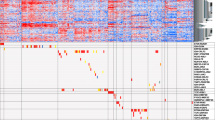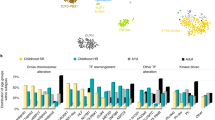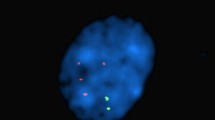Abstract
Pax5 transcription factor, also known as B-cell specific activator protein (BSAP), plays a dual role in the hematopoietic system. Pax5 expression is essential in B-cell precursors for normal differentiation and maturation of B-cells. On the other hand, it inhibits the differentiation and progress toward other lineages. The expression of this factor is involved in several aspects of B-cell differentiation, including commitment, immunoglobulin gene rearrangement, BCR signal transduction and B-cell survival, so that the deletion or inactivating mutations of Pax5 cause cell arrest in Pro-B-cell stage. In recent years, point mutations, deletions and various rearrangements in Pax5 gene have been reported in several types of human cancers. However, no clear relationship has been found between these aberrations and disease prognosis. Specific expression of Pax5 in B-cells can raise it as a marker for the diagnosis and differentiation of B-cell leukemias and lymphomas as well as account for remission or relapse. Extensive studies on Pax5 along with other genes and immunomarkers are necessary for decisive results in this regard.


Similar content being viewed by others
References
Zhou Y, You MJ, Young KH, Lin P, Lu G, Medeiros LJ, et al. Advances in the molecular pathobiology of B-lymphoblastic leukemia. Hum Pathol. 2012;43(9):1347–62.
Hütter G, Kaiser M, Neumann M, Mossner M, Nowak D, Baldus CD, et al. Epigenetic regulation of PAX5 expression in acute T-cell lymphoblastic leukemia. Leuk Res. 2011;35(5):614–9.
Nebral K, König M, Harder L, Siebert R, Haas OA, Strehl S. Identification of PML as novel PAX5 fusion partner in childhood acute lymphoblastic leukaemia. Br J Haematol. 2007;139(2):269–74.
Lang D, Powell SK, Plummer RS, Young KP, Ruggeri BA. PAX genes: roles in development, pathophysiology, and cancer. Biochem Pharmacol. 2007;73(1):1–14.
Bousquet M, Broccardo C, Quelen C, Meggetto F, Kuhlein E, Delsol G, et al. A novel PAX5-ELN fusion protein identified in B-cell acute lymphoblastic leukemia acts as a dominant negative on wild-type PAX5. Blood. 2007;109(8):3417–23.
Medvedovic J, Ebert A, Tagoh H, Busslinger M. 5 Pax5: a master regulator of B cell development and leukemogenesis. Adv Immunol. 2011;111:179.
Iacobucci I, Lonetti A, Paoloni F, Papayannidis C, Ferrari A, Storlazzi CT, et al. The PAX5 gene is frequently rearranged in BCR-ABL1-positive acute lymphoblastic leukemia but is not associated with outcome. Haematologica. 2010:haematol. 2009. 020792.
Souabni A, Jochum W, Busslinger M. Oncogenic role of Pax5 in the T-lymphoid lineage upon ectopic expression from the immunoglobulin heavy-chain locus. Blood. 2007;109(1):281–9.
Kee BL, Murre C. Transcription factor regulation of B lineage commitment. Curr Opin Immunol. 2001;13(2):180–5.
Torlakovic E, Slipicevic A, Robinson C, DeCoteau JF, Alfsen GC, Vyberg M, et al. Pax-5 expression in nonhematopoietic tissues. Am J Clin Pathol. 2006;126(5):798–804.
Usvasalo A, Ninomiya S, Räty R, Hollmén J, Saarinen-Pihkala UM, Elonen E, et al. Focal 9p instability in hematologic neoplasias revealed by comparative genomic hybridization and single-nucleotide polymorphism microarray analyses. Genes Chromosom Cancer. 2010;49(4):309–18.
Souabni A, Cobaleda C, Schebesta M, Busslinger M. Pax5 promotes B lymphopoiesis and blocks T cell development by repressing Notch1. Immunity. 2002;17(6):781–93.
Revilla‐I‐Domingo R, Bilic I, Vilagos B, Tagoh H, Ebert A, Tamir IM, et al. The B‐cell identity factor Pax5 regulates distinct transcriptional programmes in early and late B lymphopoiesis. EMBO J. 2012;31(14):3130–46.
Carotta S, Holmes M, Pridans C, Nutt SL. Pax5 maintains cellular identity by repressing gene expression throughout B cell differentiation. Cell Cycle-landes Biosci. 2006;5(21):2452.
Nutt SL, Morrison AM, Dörfler P, Rolink A, Busslinger M. Identification of BSAP (Pax-5) target genes in early B-cell development by loss-and gain-of-function experiments. EMBO J. 1998;17(8):2319–33.
Nutt SL, Urbanek P, Rolink A, Busslinger M. Essential functions of Pax5 (BSAP) in pro-B cell development: difference between fetal and adult B lymphopoiesis and reduced V-to-DJ recombination at the IgH locus. Genes Dev. 1997;11(4):476–91.
Zhang X, Lin Z, Kim I. Pax5 expression in non-Hodgkin’s lymphomas and acute leukemias. J Korean Med Sci. 2003;18(6):804.
Tiacci E, Pileri S, Orleth A, Pacini R, Tabarrini A, Frenguelli F, et al. PAX5 expression in acute leukemias higher B-Lineage specificity than CD79a and selective association with t (8; 21)-acute myelogenous leukemia. Cancer Res. 2004;64(20):7399–404.
Schebesta A, McManus S, Salvagiotto G, Delogu A, Busslinger GA, Busslinger M. Transcription factor Pax5 activates the chromatin of key genes involved in B cell signaling, adhesion, migration, and immune function. Immunity. 2007;27(1):49–63.
Fuxa M, Skok J, Souabni A, Salvagiotto G, Roldan E, Busslinger M. Pax5 induces V-to-DJ rearrangements and locus contraction of the immunoglobulin heavy-chain gene. Genes Dev. 2004;18(4):411–22.
Gonda H, Sugai M, Nambu Y, Katakai T, Agata Y, Mori KJ, et al. The balance between Pax5 and Id2 activities is the key to AID gene expression. J Exp Med. 2003;198(9):1427–37.
Nera K-P, Kohonen P, Narvi E, Peippo A, Mustonen L, Terho P, et al. Loss of Pax5 promotes plasma cell differentiation. Immunity. 2006;24(3):283–93.
Forero RM, Hernández M, Hernández-Rivas JM. Genetics of acute lymphoblastic leukemia. In: Guenova M, Balatzenko, editors. Leukemia. InTech; 2013. ISBN 978-953-51-1127-6.
Nebral K, Denk D, Attarbaschi A, König M, Mann G, Haas OA, et al. Incidence and diversity of PAX5 fusion genes in childhood acute lymphoblastic leukemia. Leukemia. 2008;23(1):134–43.
Mandel EM, Grosschedl R. Transcription control of early B cell differentiation. Curr Opin Immunol. 2010;22(2):161–7.
Strehl S, König M, Dworzak M, Kalwak K, Haas O. PAX5/ETV6 fusion defines cytogenetic entity dic (9; 12)(p13; p13). Leukemia. 2003;17(6):1121–3.
Familiades J, Bousquet M, Lafage-Pochitaloff M, Bene M, Beldjord K, De Vos J, et al. PAX5 mutations occur frequently in adult B-cell progenitor acute lymphoblastic leukemia and PAX5 haploinsufficiency is associated with BCR-ABL1 and TCF3-PBX1 fusion genes: a GRAALL study. Leukemia. 2009;23(11):1989–98.
Fazio G, Biondi A, Cazzaniga G. The role of PAX5 in ALL. Nov Asp Acute Lymphoblastic Leuk Tech. 2011.
Kawamata N, Ogawa S, Zimmermann M, Niebuhr B, Stocking C, Sanada M, et al. Cloning of genes involved in chromosomal translocations by high-resolution single nucleotide polymorphism genomic microarray. Proc Natl Acad Sci. 2008;105(33):11921–6.
Hu H, Wang B, Borde M, Nardone J, Maika S, Allred L, et al. Foxp1 is an essential transcriptional regulator of B cell development. Nat Immunol. 2006;7(8):819.
Coyaud E, Struski S, Prade N, Familiades J, Eichner R, Quelen C, et al. Wide diversity of PAX5 alterations in B-ALL: a groupe francophone de cytogenetique hematologique study. Blood. 2010;115(15):3089–97.
Denk D, Bradtke J, König M, Strehl S. PAX5 fusion genes in t (7; 9)(q11. 2; p13) leukemia: a case report and review of the literature. Mol Cytogenet. 2014;7(1):13.
Denk D, Nebral K, Bradtke J, Pass G, Möricke A, Attarbaschi A, et al. PAX5-AUTS2: a recurrent fusion gene in childhood B-cell precursor acute lymphoblastic leukemia. Leuk Res. 2012;36(8):e178–81.
Moorman AV. The clinical relevance of chromosomal and genomic abnormalities in B-cell precursor acute lymphoblastic leukaemia. Blood Rev. 2012;26(3):123–35.
Mullighan CG, Goorha S, Radtke I, Miller CB, Coustan-Smith E, Dalton JD, et al. Genome-wide analysis of genetic alterations in acute lymphoblastic leukaemia. Nature. 2007;446(7137):758–64.
An Q, Wright SL, Konn ZJ, Matheson E, Minto L, Moorman AV, et al. Variable breakpoints target PAX5 in patients with dicentric chromosomes: a model for the basis of unbalanced translocations in cancer. Proc Natl Acad Sci. 2008;105(44):17050–4.
Fortschegger K, Anderl S, Denk D, Strehl S. Functional heterogeneity of PAX5 chimeras reveals insight for leukemia development. Mol Cancer Res. 2014;12(4):595–606.
Mullighan C, Downing J. Genome-wide profiling of genetic alterations in acute lymphoblastic leukemia: recent insights and future directions. Leukemia. 2009;23(7):1209–18.
Portell CA, Wenzell CM, Advani AS. Clinical and pharmacologic aspects of blinatumomab in the treatment of B-cell acute lymphoblastic leukemia. Clin Pharmacol Adv Appl. 2013;5(Suppl 1):5.
Kang H, Roberts KG, Chen I-ML, Atlas SR, Bedrick EJ, Gastier-Foster JM, et al. Development and validation of a highly sensitive and specific gene expression classifier to prospectively screen and identify B-Precursor acute lymphoblastic leukemia (ALL) patients with a philadelphia chromosome-like (“Ph-like” or “BCR-ABL1-Like”) signature for therapeutic targeting and clinical intervention. Blood. 2013;122(21):826.
Harder L, Eschenburg G, Zech A, Kriebitzsch N, Otto B, Streichert T, et al. Aberrant ZNF423 impedes B cell differentiation and is linked to adverse outcome of ETV6-RUNX1 negative B precursor acute lymphoblastic leukemia. J Exp Med. 2013;210(11):2289–304.
Sarhadi VK, Lahti L, Scheinin I, Ellonen P, Kettunen E, Serra M, et al. Copy number alterations and neoplasia-specific mutations in MELK, PDCD1LG2, TLN1, and PAX5 at 9p in different neoplasias. Genes Chromosom Cancer. 2014;53(7):579–88.
Carotta S, Nutt SL. Losing B cell identity. BioEssays. 2008;30(3):203–7.
Sigvardsson M. Transcription factor dose links development to disease. Blood. 2012;120(18):3630–1.
Nasr MR, Rosenthal N, Syrbu S. Expression profiling of transcription factors in B-or T-Acute lymphoblastic leukemia/lymphoma and burkitt lymphoma usefulness of PAX5 immunostaining as Pan–Pre-B-Cell marker. Am J Clin Pathol. 2010;133(1):41–8.
Hutspardol S, Pakakasama S, Kanta K, Nuntakarn L, Anurathapan U, Sirachainan N, et al. Interphase-FISH screening for eight common rearrangements in pediatric B-cell precursor acute lymphoblastic leukemia. Int J Lab Hematol. 2013;35(4):406–15.
Desouki MM, Post GR, Cherry D, Lazarchick J. PAX-5: a valuable immunohistochemical marker in the differential diagnosis of lymphoid neoplasms. Clin Med Res. 2010;8(2):84–8.
Heltemes-Harris LM, Willette MJ, Ramsey LB, Qiu YH, Neeley ES, Zhang N, et al. Ebf1 or Pax5 haploinsufficiency synergizes with STAT5 activation to initiate acute lymphoblastic leukemia. J Exp Med. 2011;208(6):1135–49.
Bernt KM, Hunger SP. Current concepts in pediatric philadelphia chromosome-positive acute lymphoblastic leukemia. Fron Oncol. 2014.
Mullighan CG, Su X, Zhang J, Radtke I, Phillips LA, Miller CB, et al. Deletion of IKZF1 and prognosis in acute lymphoblastic leukemia. N Engl J Med. 2009;360(5):470–80.
Slamova L, Starkova J, Fronkova E, Zaliova M, Reznickova L, van Delft FW, et al. CD2-positive B-cell precursor acute lymphoblastic leukemia with an early switch to the monocytic lineage. Leukemia. 2014;28(3):609–20.
Lundin C, Hjorth L, Behrendtz M, Nordgren A, Palmqvist L, Andersen MK, et al. High frequency of BTG1 deletions in acute lymphoblastic leukemia in children with Down syndrome. Genes Chromosom Cancer. 2012;51(2):196–206.
Kearney L, De Castro DG, Yeung J, Procter J, Horsley SW, Eguchi-Ishimae M, et al. Specific JAK2 mutation (JAK2R683) and multiple gene deletions in Down syndrome acute lymphoblastic leukemia. Blood. 2009;113(3):646–8.
Zhang H. The molecular mechanisms for maintenance of cancer stem cells in chronic myeloid leukemia: a dissertation. 2012.
Zhang H, Peng C, Hu Y, Li H, Sheng Z, Chen Y, et al. The Blk pathway functions as a tumor suppressor in chronic myeloid leukemia stem cells. Nat Genet. 2012;44(8):861–71.
Ray D, Kwon SY, Ptasinska A, Bonifer C. Chronic growth factor receptor signaling and lineage inappropriate gene expression in AML: the polycomb connection. Cell Cycle. 2013;12(14):2159.
Sadakane Y, Zaitsu M, Nishi M, Sugita K, Mizutani S, Matsuzaki A, et al. Expression and production of aberrant PAX5 with deletion of exon 8 in B-lineage acute lymphoblastic leukaemia of children. Br J Haematol. 2007;136(2):297–300.
Ray D, Kwon SY, Tagoh H, Heidenreich O, Ptasinska A, Bonifer C. Lineage-inappropriate PAX5 expression in t (8; 21) acute myeloid leukemia requires signaling-mediated abrogation of polycomb repression. Blood. 2013;122(5):759–69.
Zheng J, Dong S, Wang Q, Pan J, Chen S, Qiu H. Deletions and rearrangements of PAX5 gene in B-lineage acute lymphoblastic leukemia. Zhonghua yi xue yi chuan xue za zhi = Zhonghua yixue yichuanxue zazhi = Chin J Med Genet. 2013;30(5):549.
Zakaria Z, Ahid MFM, Ismail A, Keoh TS, Nor NM, Kamaluddin NR, et al. Chromosomal aberrations in ETV6/RUNX1-positive childhood acute lymphoblastic leukemia using 244 K Oligonucleotide array comparative genomic hybridization. Mol Cytogenet. 2012;5(1):41.
Pasqualucci L, Neumeister P, Goossens T, Nanjangud G, Chaganti R, Küppers R, et al. Hypermutation of multiple proto-oncogenes in B-cell diffuse large-cell lymphomas. Nature. 2001;412(6844):341–6.
McCune RC, Syrbu SI, Vasef MA. Expression profiling of transcription factors Pax-5, Oct-1, Oct-2, BOB. 1, and PU. 1 in Hodgkin’s and non-Hodgkin’s lymphomas: a comparative study using high throughput tissue microarrays. Mod Pathol. 2006;19.
García-Cosío M, Santón A, Martín P, Camarasa N, Montalbán C, García JF, et al. Analysis of transcription factor OCT. 1, OCT. 2 and BOB. 1 expression using tissue arrays in classical Hodgkin’s lymphoma. Mod Pathol. 2004;17(12):1531–8.
Theil J, Laumen H, Marafioti T, Hummel M, Lenz G, Wirth T, et al. Defective octamer-dependent transcription is responsible for silenced immunoglobulin transcription in Reed–Sternberg cells. Blood. 2001;97(10):3191–6.
Saki N, Abroun S, Hajizamani S, Rahim F, Shahjahani M. Association of chromosomal translocation and miRNA expression with the pathogenesis of multiple myeloma. Cell J. 2014;16(2):99–110.
Zheng X, Abroun S, Otsuyama K-i, Asaoku H, Kawano MM. Heterogeneous expression of CD32 and CD32-mediated growth suppression in human myeloma cells. Haematologica. 2006;91(7):920–8.
Borson ND, Lacy MQ, Wettstein PJ. Altered mRNA expression of Pax5 and Blimp-1 in B cells in multiple myeloma. Blood. 2002;100(13):4629–39.
Martins G, Calame K. Regulation and functions of Blimp-1 in T and B lymphocytes. Annu Rev Immunol. 2008;26:133–69.
Torlakovic E, Torlakovic G, Nguyen PL, Brunning RD, Delabie J. The value of anti-pax-5 immunostaining in routinely fixed and paraffin-embedded sections: a novel pan pre-B and B-cell marker. Am J Surg Pathol. 2002;26(10):1343–50.
Morgenstern DA, Hasan F, Gibson S, Winyard P, Sebire NJ, Anderson J. PAX5 Expression in nonhematopoietic tissues reappraisal of previous studies. Am J Clin Pathol. 2010;133(3):407–15.
O’Brien P, Morin P, Ouellette RJ, Robichaud GA. The Pax-5 gene: a pluripotent regulator of B-cell differentiation and cancer disease. Cancer Res. 2011;71(24):7345–50.
Cazzaniga G, Daniotti M, Tosi S, Giudici G, Aloisi A, Pogliani E, et al. The paired box domain gene PAX5 is fused to ETV6/TEL in an acute lymphoblastic leukemia case. Cancer Res. 2001;61(12):4666–70.
Chisté M, Vrotsos E, Zamora C, Martinez A. Chronic lymphocytic leukemia/small lymphocytic lymphoma involving the aortic valve. Ann Diagn Pathol. 2013;17(3):295–7.
Bharti B, Mishra R. Isoforms of Pax5 and co-regulation of T-and B-cells associated genes influence phenotypic traits of ascetic cells causing Dalton’s lymphoma. Biochimica et Biophysica Acta (BBA)-Mol Cell Res. 2011;1813(12):2071–8.
Kim M, Choi JE, She CJ, Hwang SM, Shin HY, Ahn HS, et al. PAX5 deletion is common and concurrently occurs with CDKN2A deletion in B-lineage acute lymphoblastic leukemia. Blood Cells Mol Dis. 2011;47(1):62–6.
Russell LJ, Akasaka T, Majid A, Sugimoto K-j, Karran EL, Nagel I, et al. t (6; 14)(p22; q32): a new recurrent IGH@ translocation involving ID4 in B-cell precursor acute lymphoblastic leukemia (BCP-ALL). Blood. 2008;111(1):387–391.
Acknowledgments
We wish to thank all our colleagues in Shafa Hospital and Allied Health Sciences School, Ahvaz Jundishapur University of Medical Sciences.
Conflict of interest
None.
Author information
Authors and Affiliations
Corresponding author
Rights and permissions
About this article
Cite this article
Shahjahani, M., Norozi, F., Ahmadzadeh, A. et al. The role of Pax5 in leukemia: diagnosis and prognosis significance. Med Oncol 32, 360 (2015). https://doi.org/10.1007/s12032-014-0360-6
Received:
Accepted:
Published:
DOI: https://doi.org/10.1007/s12032-014-0360-6




